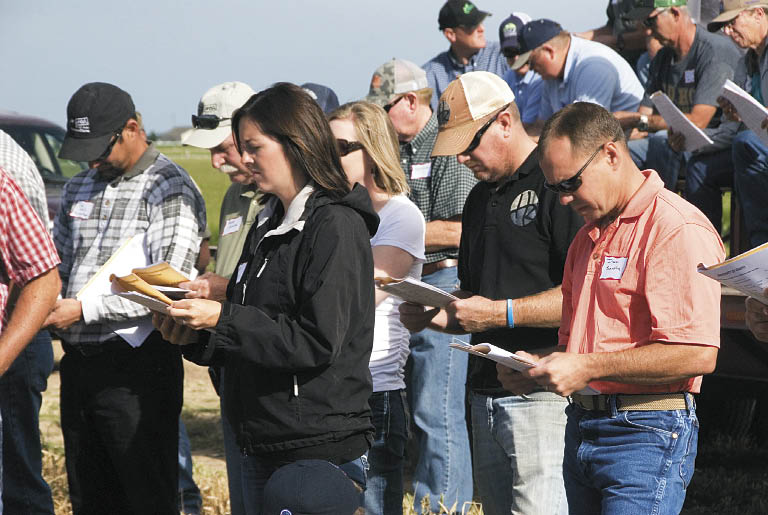 University of Idaho Extension scientists met with more than 125 visitors at the annual Snake River Pest Management Tour on June 25 in Kimberly, Idaho.
University of Idaho Extension scientists met with more than 125 visitors at the annual Snake River Pest Management Tour on June 25 in Kimberly, Idaho.
Researchers gave insights into several trials under way of interest to sugarbeet growers. Dr. Don Morishita, weed scientist and superintendent of the Kimberly Research & Extension Center, is investigating weed control in sugarbeets in one trial with a new un-registered herbicide that has soil residual activity.
"There are not many herbicides available that do provide residual weed control," he said. "That would be a real bonus for growers to have that."
The one-year trail will conclude at harvest. Morishita expects another modified study will follow next year.
In another trial, Morishita is examining weed resistance management tank mixtures in Roundup Ready sugarbeets.
"The purpose of this is to look at some different tank mixtures with Roundup and some herbicides that are applied pre-emergence to the crop," he said. "Liberty 280 is a different mode of action, but it's similar to Roundup in that it's nonselective, and it doesn't have any soil residual activity. It'll just kill any weeds that are up.
"Unfortunately, it didn't work well in this experiment, because we didn't have many weeds that were up when we applied it," Morishita said.
Nortron was used a lot in conventional sugarbeets. Morishita said researchers are trying to fit that in growers' weed control programs. This may give growers another mode of action to use for weed control besides Roundup.
"Nortron and Outlook are probably the soil-applied herbicides in sugarbeets that are working the best," Morishita said. "Dual Magnum is another one that works quite well. Warrant isn't registered for use in sugarbeets yet, but it has the same mode of action as Outlook and Dual Magnum. We will know more after harvest." Studies like this focus on the worry of weeds becoming resistant to glyphosate.
Another large study led by Morishita examines the effects of fertilizer rate, irrigation and tillage on diseases, insects and weeds in sugarbeets.
"We're comparing growing sugarbeets under conventional tillage, strip tillage and direct seeding (no tillage) with different irrigation levels," he said. "Our thinking is evapotranspiration (ET) for direct-seeded sugarbeets is going to be lower than ET would be for conventional tillage, which in a short water year, this could be a significant advantage."
In the study, irrigation rates are used at 50 percent, 100 percent and 150 percent of ET along with different fertility rates ranging from 50 percent to 125 percent. Researchers use the daily ET rates published by AgriMet.
"The amount of crop residue on the soil surface can play a role," Morishita said. "If you have this bare surface, soil water is going to evaporate at a different rate than if you had straw residue like in our direct-seed."
Strip tillage lies between conventional tillage and direct-seed.
"Shanks till up a narrow strip that we plant the crop in," Morishita said. "According to proponents of the strip till you're making this fine seed bed, and yet you're still leaving a whole lot of crop residue to reduce wind erosion and water loss."
This year's study has more crop residue in the field.
"Previous studies hadn't looked at different irrigation and fertility levels," Morishita said. "It's just been the response to different tillage. Our plan is to do this study for two years."
Another large study in its second year examines the effect of sprinkler incorporation timing on the activity of soil-active herbicides applied with glyphosate.
The goal is to determine how long soil herbicides remain stable on the soil surface before they're incorporated into the soil.
"Most growers do it well within three days and that would be a very realistic goal," Morishita said. "But we wanted to take this to the extreme, so we could tell them you can definitely wait up to three days. That's kind of the way it's looking."
In this study, treatment is applied at zero, three, six and nine days before irrigation.
"Nortron and Outlook look best at six and three days in the 2012 study," Morishita said.
Growers might also be interested in a study comparing various adjuvants with glyphosate for weed control and crop tolerance in sugarbeets. There are many generic glyphosates after Monsanto's patent for Roundup Ready expired. Treatments include Cornerstone Plus and Roundup PowerMax.
Additionally entomologist Dr. Erik Wenninger is comparing seed treatments for the management of beet leafminer flies.
A second study of his involves insecticide efficacy trials against beet leafminer, bean aphid and sugarbeet root aphid.
Plant pathologist Dr. Oliver Neher is examining the variety and irrigation treatment response of pathogens and insect pests in a collaborative project with Wenninger.
Neher is looking for control of Rhizoctonia root rot with in-furrow and foliar applied fungicides.
He's also seeking control of Rhizoctonia damping-off and other damping-off pathogens with seed-applied fungicides.
Upon completion of studies, Morishita said results will be published.